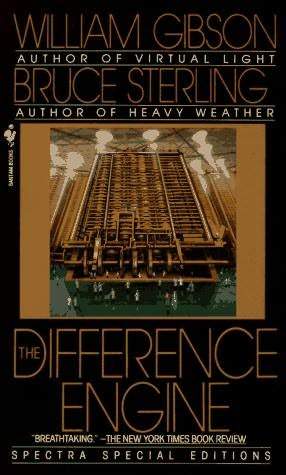 Steampunk is a relatively recent genre that mixes the image of a cyberpunk dystopia with the technology and culture of the Victorian Empire. I thought it was a fairly common motif, but it appears not to be as I can find very few other novels with this motif. With The Difference Engine, these two leading cyberpunk authors have joined together to produce an alternate history novel. The novel’s premise is that Charles Babbage did build his Analytical Engine and that a steam-driven information age has developed as a result — and Britain is under the control of the socialists and intellectuals under the leadership of none other than Lord Byron. As a result, everything technological is easily a hundred years ahead of where it should be for Eighteen Fifties Britain. The premise of the novel is that the difference engine — see below for what it was — was not only built, but writ large upon the British culture.
Steampunk is a relatively recent genre that mixes the image of a cyberpunk dystopia with the technology and culture of the Victorian Empire. I thought it was a fairly common motif, but it appears not to be as I can find very few other novels with this motif. With The Difference Engine, these two leading cyberpunk authors have joined together to produce an alternate history novel. The novel’s premise is that Charles Babbage did build his Analytical Engine and that a steam-driven information age has developed as a result — and Britain is under the control of the socialists and intellectuals under the leadership of none other than Lord Byron. As a result, everything technological is easily a hundred years ahead of where it should be for Eighteen Fifties Britain. The premise of the novel is that the difference engine — see below for what it was — was not only built, but writ large upon the British culture.
While others were developing the first successful mechanical calculators, Charles Babbage became aware as early as 1812 that many long computations consisted of operations that were regularly repeated. He speculated that it must be possible to design a calculating machine which could do these operations automatically. He produced a prototype of this “difference engine” by 1822 and, with the help of financing from the British government, started work on the full machine in 1823. It was intended to be steam-powered; fully automatic, even to the printing of the resulting tables, and commanded by a fixed instruction program. In essence, it was a steam-powered mechanical computer. (The novel calls them “clackers.”) Oddly enough, the world of this novel could very nicely fit into the world created for The Secret Adventures of Jules Verne sErie’s.
The London of The Difference Engine is no more real than the city in Bone Dance which is constructed out of Minneapolis — both are fictions built (loosely) upon the real landscapes. And both are nightmare cities in different ways: the Bone Dance city is post-collapse, while this London is headed towards collapse, both physically and psychologically. The policies of rapid, uncontrolled industrial development have London and the surrounding area rather devastated.
Elisabeth Kraus, in her brilliant essay on this novel, asserts that the authors created a ” … technoculture in which the human and the mechanical easily merge.” What I will note is that this is an amazingly complex novel and you have to understand quite a bit of Victorian culture and technology; you’d better know the significant historic figures of the time; and it helps to have a grasp of mad English poets. Why so? Because there’s absolutely no explanations in this book — much of this novel will be lost on you and you will become very, very confused. You will be deep within a semi-fictional culture that is, to a point, supposed to be a form of retro future shock.
Note that I haven’t discussed the plot, the characters, or the circumstances of this novel. And I won’t, as that would spoil your reading of it. My only minor criticism of The Difference Engine is that it really isn’t a novel, but rather a series of more or less interconnected tales. If you like Gibson’s Neuromancer trilogy, you’ll find this to your liking as this reads like classic Gibson. It certainly is a version of London that’s like no other! I know that it’s supposed to be the work of two writers, but it feels like it was written only by Gibson. Is it worth reading? Certainly. And after you read, hunt down Tim Power’s The Anubis Gates, as it’s another fine example of steampunk with many of the same personas showing up in both novels.
(Bantam Books, 1991)
